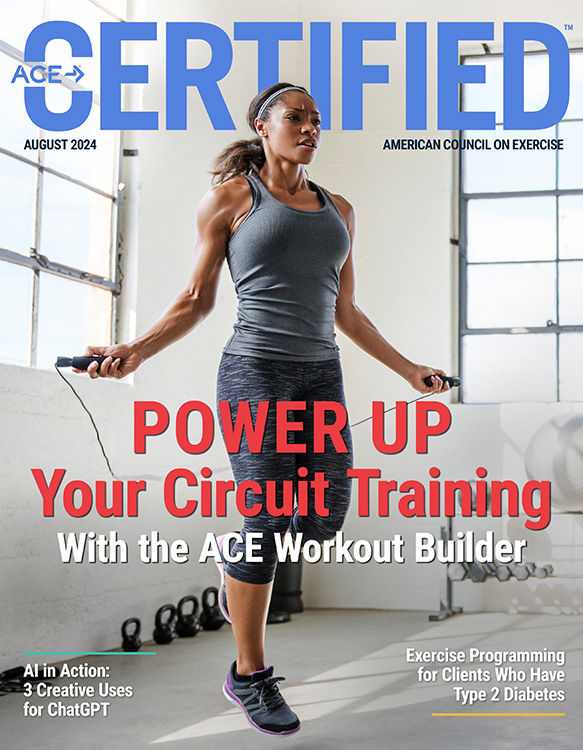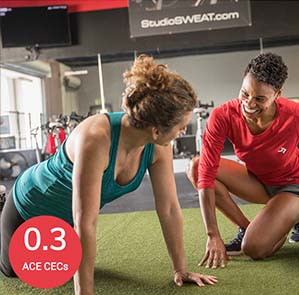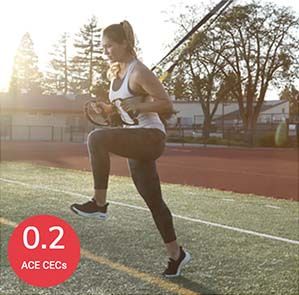
Editor’s Note: As a health coach or exercise professional, you are well aware of the transformative power of physical activity. This article provides a unique perspective on how running, an instinctual and primal form of movement, is integral to our human experience. Understanding this connection can deepen your appreciation of the workouts you design and inspire your clients to embrace their physicality in new ways. Written by Jason Karp, PhD, MBA, a running coach, exercise physiologist, writer and visiting professor of exercise physiology at Georgia Southern University, this article is based on the TEDx talk he gave in Rexberg, Idaho, How Running Like an Animal Makes Us Human, and adapted from his book, Work Out: The Revolutionary Method of Creating a Sound Body to Create a Sound Mind. Through both storytelling and research, Karp delves into the profound connection between physical movement and our humanity. By the end of this article, you will have a richer understanding of how to harness the full potential of physical exercise to benefit your clients’ overall health. And, importantly, you will be better prepared to inspire and guide them on their journey to becoming stronger, healthier and more connected to their intrinsic human nature.
Key Takeaways
- Holistic Approach to Health: Discover how running and other forms of physical exercise are not just about improving physical health but also enhancing mental and emotional well-being.
- Inspiration Through Stories: Learn from Ronnie Goodman’s inspiring journey and how running became a beacon of hope and creativity for him. His story can be a powerful tool to motivate and connect with clients facing their own challenges.
- Scientific Insights: Gain insights into the science behind how physical activity influences brain chemistry and function, supporting better mental health and cognitive performance.
- Practical Applications: Equip yourself with evidence-based strategies to create workouts that foster not only physical strength but also mental resilience and creativity.
He Painted and He Ran: Ronnie Goodman’s Story
Walking down Haight Street in San Francisco, I came across a small art studio with a 1960s-looking storefront, a not-uncommon sight in the legendary Haight-Ashbury district. Inside the studio, an African American man with a gray goatee and a beanie sat on a stool and painted on a canvas. His artwork, much of which depicts scenes of San Francisco, adorned the walls.
Ronnie Goodman was a self-taught artist in San Francisco. Before his death in 2020 at age 60, he had been painting nearly all his life. His art, he said, was inspired by the beauty and diversity of San Francisco, balanced with the struggles of human despair.
“With my brush, I try to capture these raw emotions in painted images of the city,” he told me, five years before he died. “I have a story to tell. I think I have a lot to say. It’s very hard to make a living as an artist. The most important thing is that I don’t give up.”
When Goodman wasn’t painting, he ran. He ran up to 50 miles per week on the streets of San Francisco, often wearing a Tamalpa Racing singlet from the local Tamalpa Runners running club. He ran countless half-marathons, including the San Francisco Half-Marathon to celebrate his birthday in July 2014. He even ran the famous Dipsea Trail Race in Marin County, Calif., the oldest trail race in America.
If you had the chance to talk to Goodman about his experiences of being a runner, it wouldn’t have taken long to discover that his running and painting were intertwined. He spoke from his heart, yet was often nonchalant about things, brushing them off as if they were nothing special.
“Running helps inspire me as an artist,” he explained to me. “When I get stuck creating a piece of work, running helps me step back from the canvas and put ideas together. I can look at the canvas in my imagination.”
Goodman was all too familiar with the human despair that infused the art he made in his studio on Haight Street. Experiencing depression after his mother passed away, he tried to self-medicate with drugs, using marijuana, heroin and cocaine. He spent eight years in San Quentin Prison for burglary, and experienced homeless for 20 years. He had four kids, one of whom was stabbed to death. His ex-wife didn’t want anything to do with him when he became a drug addict. “Once you get into drugs, you lose everything,” he said.
Sober for the last 17 years of his life, Goodman lived a pretty simple existence on the streets in San Francisco. He painted and he ran. Even without having much to his name, he still gave back to the community that had supported his painting and running. He managed the studio in exchange for being able to paint in it, and he sold his prints, posters, greeting cards and T-shirts in the art studio and on his website. He donated his artwork to churches, and he fundraised for Hospitality House, an organization that provides programs for San Francisco’s homeless community.
Goodman had been running on and off since elementary school. He was competitive in middle school but didn’t get serious about running until much later in life. Ironically, it was when he was in prison and met a volunteer named Frank, who started the 1,000 Miles Running Club at the prison. He joined so that he could do something healthy for himself.
While in prison, Goodman ran four times per week for 60 to 90 minutes—around the prison’s courtyard. He even ran four marathons while in prison—105 laps around a quarter-mile track.
“Running gets you into a meditative mode,” he said slowly, as if he were meditating within his words. “It makes you see things differently. If I’m going through something that might have happened the day before that made me feel depressed, I put on my shoes and run, and it’s like, ‘Oh, it’s a wrap; it’s over with. I just ran, I feel good. I don’t need to stick to those feelings that made me feel bad. I’m feeling good now, and I’m going to stick with that.’”
When I asked the former drug addict and ex-con how he ran while experiencing homelessness, he said, “I just do.” There’s little more to that answer.
When asked why he runs, I got an answer that had a lot more to it. “When I’m running, I feel like I’m not there. I feel like I’m somewhere else. I feel like I’m inside of myself. It’s like this spiritual moment that I’m just running and running. I might run for two hours, and I’m a free person for those two hours.”
After his release, Goodman sometimes ran with his friend Frank, the prison volunteer who started the 1,000 Miles Running Club. But he usually ran alone, using his runs to imagine and create the art that he painted later that day.
Some people might have looked at Ronnie Goodman and felt sorry for him, having died alone, in his encampment in the Mission District of San Francisco. But he didn’t feel sorry for himself. Quite the contrary. In many ways, he turned his life around, and he lived the life that he wanted to live, painting and running and giving back to the community with his art.
I finished my conversation with Goodman by asking him what he wanted people to know about him.
“I just want people to know I’m an artist and a runner. It makes me feel alive.”
Training the Body Changes the Brain
Feeling alive. Isn’t that what most of us—your clients included—want to feel? But somewhere between chasing other animals for food and clicking a mouse to purchase a toaster oven on Amazon.com, many people have stopped living a physical life. Instead, we’ve been encouraged to work on our inner selves, to practice mindfulness, to meditate and to get our minds right. Law of attraction followers say that our thoughts directly change our lives, that we can manifest what we want from the universe. Parents, teachers, Olympic athletes and practically everyone else tell us that we can achieve anything that we set our minds to. Prominent people tell us to start from our why and look inward to live our best life.
But that’s not the whole picture. We are physical animals, first. By focusing on making our physical bodies strong, resilient and enduring, we strengthen our belief in ourselves and what we can do. This transformation isn’t some pseudo-holistic platitude, with false promises that making bigger biceps makes you confident and successful. It’s science. And it’s true whether you are a health and exercise professional or a novice exerciser. By working on the outside, we can actually alter our physiology, change our brain chemistry and change our outlook on life…and on ourselves.
Countless scientific studies have shown that exercise causes profound changes on the inside that positively affect your creativity, your cognition and your confidence, from the opioids and cannabinoids released in the brain that cause a perceived euphoria—the “runner’s high”—to the increase in serotonin that makes exercise as effective as prescription drugs for ameliorating depression in some people, to neurogenesis—the formation of new neurons in the brain—that improves the way we think, including our problem-solving, creativity, memory and learning. Research has shown that people perform better on tests of creative thinking after exercise compared to when the tests are taken without exercising first. Neurogenesis even occurs across different species—research has shown that mice given access to a running wheel for a few months have more than twice the number of new cells formed in their brains compared to mice with no access to a running wheel. Whether you are a mouse or a human, a sound body creates a sound mind.
Body, Brain, Mind
Every human has three parts: body, brain and mind. When they work together and are equally balanced, life is great and hums along the way it is supposed to. The body is strong, resilient and enduring; the brain is buzzing with electrical activity; and the mind is analytical, confident and emotionally intelligent, navigating challenges and figuring out solutions to problems.
Unfortunately, few people are blessed with such a balance. Body, brain, and mind often work in conflict with one another. They all want to be the boss.
But there can be only one boss. And the body is the boss. While the brain oversees the body’s entire operation, it works in service to the body. The human brain evolved from the body’s movements to regulate the body and manage its physiology so that it can efficiently move and interact with the larger world. Walking and running on two legs, which evolved from the anatomical change in the pelvis and is among the most complex and sophisticated of all physical movements, was the basis for the evolution of the human brain. Physical activity is so essential to the brain that it is imperative for it to function properly.
For any of us to live fully, we need to see the body and the brain as interconnected parts of the same entity, of the same human experience. To fully understand the role each part plays in our lives, in the way we see and interact with the world, we have to see the brain as part of our whole physical existence, not separate from the whole. Our brains never work by themselves. Training the body changes the brain, which affects the mind. Training the body eliminates the conflict that sometimes exists between the body, brain and mind, making all three parts work in harmony.
Inevitably, there are times in our lives that will test us, that will throw us back on our heels. But if we remember where we came from, if we remember that we are indeed animals with biology similar to that of many other animals, then we will remember that to live life fully, we must fully live physically. Of course, it’s not enough to read about how training the body changes the brain, which affects the mind. We need to act on what we learn.
It’s time to get moving.
Workouts to Better the Body, Brain and Mind
The workouts presented below are challenging and designed to help your clients build strong, powerful and agile bodies, which in turn will enhance and strengthen their brains and minds as well. Be sure your clients have a sufficient level of fitness prior to introducing these sample workouts into their exercise programs.
Workout 1: Running or Cycling VO2max Intervals
5 reps | 3 minutes | 2 minutes recovery
VO2max workouts alternate periods of high-intensity (hard-effort) exercise and low-intensity (easy-effort) recovery. Keep the recovery intervals active to keep oxygen consumption elevated throughout the workout. This helps your clients reach their VO2max sooner during each subsequent rep, enabling them to spend more time working at their VO2max intensity during the workout.
You can have your clients do this workout using ratings of perceived exertion (RPE) or a percentage of their maximal heart rate (HR). Have them warm up prior to the workout, starting at a low intensity and progressing to a higher intensity to create a smooth transition from the warm-up to the workout. Begin the workout within a couple of minutes of completing the warm-up.
|
|
Duration (minutes)
|
RPE (0–10 scale)
|
Intensity
|
|
Rep #1
|
3:00
|
9
|
>95% max HR
|
|
Recovery
|
2:00
|
2–3
|
~64% max HR
|
|
Rep #2
|
3:00
|
9
|
>95% max HR
|
|
Recovery
|
2:00
|
2–3
|
~64% max HR
|
|
Rep #3
|
3:00
|
9
|
>95% max HR
|
|
Recovery
|
2:00
|
2–3
|
~64% max HR
|
|
Rep #4
|
3:00
|
9
|
>95% max HR
|
|
Recovery
|
2:00
|
2–3
|
~64% max HR
|
|
Rep #5
|
3:00
|
9
|
>95% max HR
|
Workout 2: Obstacle Course
Imagine running over rough terrain while scaling walls, climbing ropes and crawling through mud. Obstacle-course workouts test an individual’s overall athletic ability, including strength, endurance and muscle power. The complex movements and changing skills throughout the workout also serve to challenge the brain. Perhaps the most well-known obstacle-course competitions are Spartan races, which vary in difficulty and distance, from three miles to a marathon.
Try this simulation workout or create your own. You may be able to find a public obstacle course in your area, but playgrounds can serve as a good substitute. Run on grass, dirt or rugged terrain, and move immediately from one exercise to the next.
|
Activity
|
Time/Reps
|
|
Run
|
5–10 minutes
|
|
Burpees
|
10–20
|
|
Run
|
5–10 minutes
|
|
Monkey bars
|
swing from one end to other
|
|
Run
|
5–10 minutes
|
|
Fence climb
|
Climb over and back
|
|
Run
|
5–10 minutes
|
|
Rope climb
|
Climb up and down
|
|
Run
|
5–10 min
|
|
Chin-ups or Pull-ups
|
10
|
Workout 3: Running or Cycling Sprint Ladder
2 sets | 5 reps | 10–50 seconds | 1:2 work:recovery ratio
This sprint interval workout alternates periods of fast effort and easy effort recovery. The fast efforts should feel like sprinting, but not so fast that that your client can’t repeat the same intensity after the short recovery. Keep the recovery intervals active.
Have your client warm up prior to the workout, starting at a low intensity and progressing to a higher intensity to create a smooth transition from the warm-up to the workout. For example, warm up for 10 minutes at a low intensity, followed by a few bursts at a high intensity for 10 seconds to prime their muscles for the intensity of the workout. Encourage them to take enough time to recover between each burst since these bursts are not part of the workout and shouldn’t cause fatigue; they are only meant to prepare the body for the intensity of the workout. Begin the workout within a couple of minutes of completing the warm-up.
|
|
Duration (minutes:seconds)
|
Intensity
|
|
Set #1
|
|
Rep #1
|
0:10
|
Fast
|
|
Recovery
|
0:20
|
Easy jog or cycle
|
|
Rep #2
|
0:20
|
Fast
|
|
Recovery
|
0:40
|
Easy jog or cycle
|
|
Rep #3
|
0:30
|
Fast
|
|
Recovery
|
1:00
|
Easy jog or cycle
|
|
Rep #4
|
0:40
|
Fast
|
|
Recovery
|
1:20
|
Easy jog or cycle
|
|
Rep #5
|
0:50
|
Fast
|
|
Recovery
|
1:40
|
Easy jog or cycle
|
|
Set #2
|
|
Rep #1
|
0:10
|
Fast
|
|
Recovery
|
0:20
|
Easy jog or cycle
|
|
Rep #2
|
0:20
|
Fast
|
|
Recovery
|
0:40
|
Easy jog or cycle
|
|
Rep #3
|
0:30
|
Fast
|
|
Recovery
|
1:00
|
Easy jog or cycle
|
|
Rep #4
|
0:40
|
Fast
|
|
Recovery
|
1:20
|
Easy jog or cycle
|
|
Rep #5
|
0:50
|
Fast
|
|
Recovery
|
1:30
|
Easy jog or cycle
|
Workout 4: Basketball Sprint and Shoot Circuit for Cognitive Flexibility
4 sprints | 6 shots | 5 circuits | 2 minutes recovery
This workout forces the client to focus and aim when breathing hard. From the baseline of a basketball court, have your client sprint the length of the court to the opposite baseline and back, to the opposite free-throw line and back, to the mid-court line and back, and to the near free-throw line and back. When they get to each free-throw line, have them take three shots. To challenge the brain even more, have the client dribble a basketball while sprinting and then take a lay-up shot at each end of the court. They can also run and take shots from different parts of the court. Have them recover for two minutes before repeating the circuit.
Expand Your Knowledge
Exercise Programming Toolkit – Course Bundle
The ACE Integrated Fitness Training® Model Exercise Programming Toolkit course bundle explores the different components of the ACE IFT® Model, including the ACE Mover MethodTM, to help you develop safe and effective exercise plans. By gaining an understanding of how to move through the phases of the ACE IFT Model, you will be able to effectively educate clients and gain their trust, keeping them safe as they move toward their goals.
TRX for Runners
Designed for health and fitness professionals, this course equips you with the essential skills to merge TRX Suspension Training™ into runner-specific training plans. By focusing on strength, stability, and mobility, you can help runners enhance their performance while minimizing injury risks.Whether you're aiming to assist beginners or seasoned athletes, this course offers tailored strategies to improve cardiovascular endurance alongside crucial strength and flexibility training. Stand out in the fitness market by expanding your services and developing specialized training programs that cater directly to runners’ needs.





 by
by 




